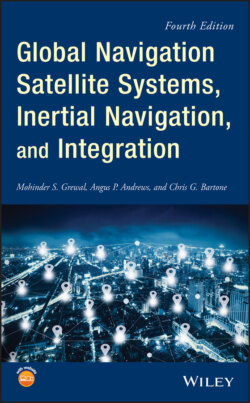Читать книгу Global Navigation Satellite Systems, Inertial Navigation, and Integration - Mohinder S. Grewal - Страница 123
Accuracy
ОглавлениеA rough rule‐of‐thumb for gyrocompass alignment accuracy is
(3.15)
where
is the minimum achievable root‐mean‐square (RMS) alignment error in radians,
is the RMS accelerometer accuracy in 's,
is the RMS gyroscope accuracy in degrees per hour,
15 deg/h is the rotation rate of the Earth, and
is the latitude at which gyrocompassing is performed.
Alignment accuracy is also a function of the time allotted for it, and the time required to achieve a specified accuracy is generally a function of sensor error magnitudes (including noise) and the degree to which the vehicle remains stationary.
Gimbaled implementation. Gyrocompass alignment for gimbaled systems is a process for aligning the inertial platform axes with the navigation coordinates using only the sensor outputs while the host vehicle is essentially stationary. For systems using ENU navigation coordinates, for example, the platform can be tilted until two of its accelerometer inputs are zero, at which time both input axes will be horizontal. In this locally leveled orientation, the sensed rotation axis will be in the north–up plane, and the platform can be slewed about the vertical axis to null the input of one of its horizontal gyroscopes, at which time that gyroscope input axis will point east–west. That is the basic concept used for gyrocompass alignment, but practical implementation requires filtering5 to reduce the effects of sensor noise and unpredictable zero‐mean vehicle disturbances due to loading activities and/or wind gusts.
Strapdown implementation. Gyrocompass alignment for strapdown systems is a process for “virtual alignment” by determining the sensor cluster attitude with respect to navigation coordinates using only the sensor outputs while the system is essentially stationary.
Error‐free implementation. If the sensor cluster could be firmly affixed to the Earth and there were no sensor errors, then the sensed acceleration vector in sensor coordinates would be in the direction of the local vertical, the sensed rotation vector would be in the direction of the Earth rotation axis, and the unit column vectors
(3.16)
(3.17)
(3.18)
would define the initial value of the coordinate transformation matrix from sensor‐fixed coordinates to ENU coordinates:
(3.19)
Practical implementation. In practice, the sensor cluster is usually mounted in a vehicle that is not moving over the surface of the Earth, but may be buffeted by wind gusts or disturbed during fueling and loading operations. Gyrocompassing then requires some amount of filtering (Kalman filtering, as a rule) to reduce the effects of vehicle buffeting and sensor noise. The gyrocompass filtering period is typically on the order of several minutes for a medium‐accuracy INS but may continue for hours, days, or continuously for high‐accuracy systems.
